
"Sowing doubt, without proof": One Nation animations exploit boundary between satire and disinformation
One Nation leader Senator Pauline Hanson has been pushing the boundaries with her YouTube videos. Her party’s satirical segments have peddled a mix of informative, misleading and false messages.
What is the difference between misinformation and political satire? When does malicious content seeded with lies but presented by a political party as humour, amount to weaponised messaging?
One Nation leader Senator Pauline Hanson has been pushing the boundaries with her YouTube videos. Her party’s satirical segments have peddled a mix of informative, misleading and false messages.
The One Nation strategy of deliberately blurring the boundaries between satire and misinformation has been called out by the Australian Electoral Commission (AEC). On April 29, the AEC made a formal complaint to Facebook and TikTok regarding Episode 24 of One Nation’s cartoon series “Please Explain”.
The platforms subsequently took down the video. The episode had falsely portrayed federal Labor Party MPs discussing plans to boost their votes in the election with fake postal ballots. The video also included the false claim that the 2010 election, which led to a minority government, was won by individual electors submitting multiple ballots.
The video fires up community anxiety about possible election fraud and calls for the introduction of voter identification at the ballot box. The narrative is derived from strategies adopted in the 2020 US presidential election by then-president Donald Trump and his supporters who called for voter ID to stop the “election steal”.
The Australian Electoral Commission is reported to have told the platforms that the episode spread false claims about election fraud in Australia. The video was later removed from Facebook, TikTok, Twitter and Youtube.
One Nation pushed back, issuing two public statements. The first, published on April 29, criticised the AEC’s decision and repeated allegations of voter fraud raised in the banned episode. In the post, Senator Hanson claimed “Senate estimate hearings have clearly identified issues with voter fraud”, adding that marginal seats across the country “run the risk of being won or lost through voter fraud unless we tighten identification laws”.
The post also doubled down on the party’s suggestion that Labor may have engaged in voter fraud.
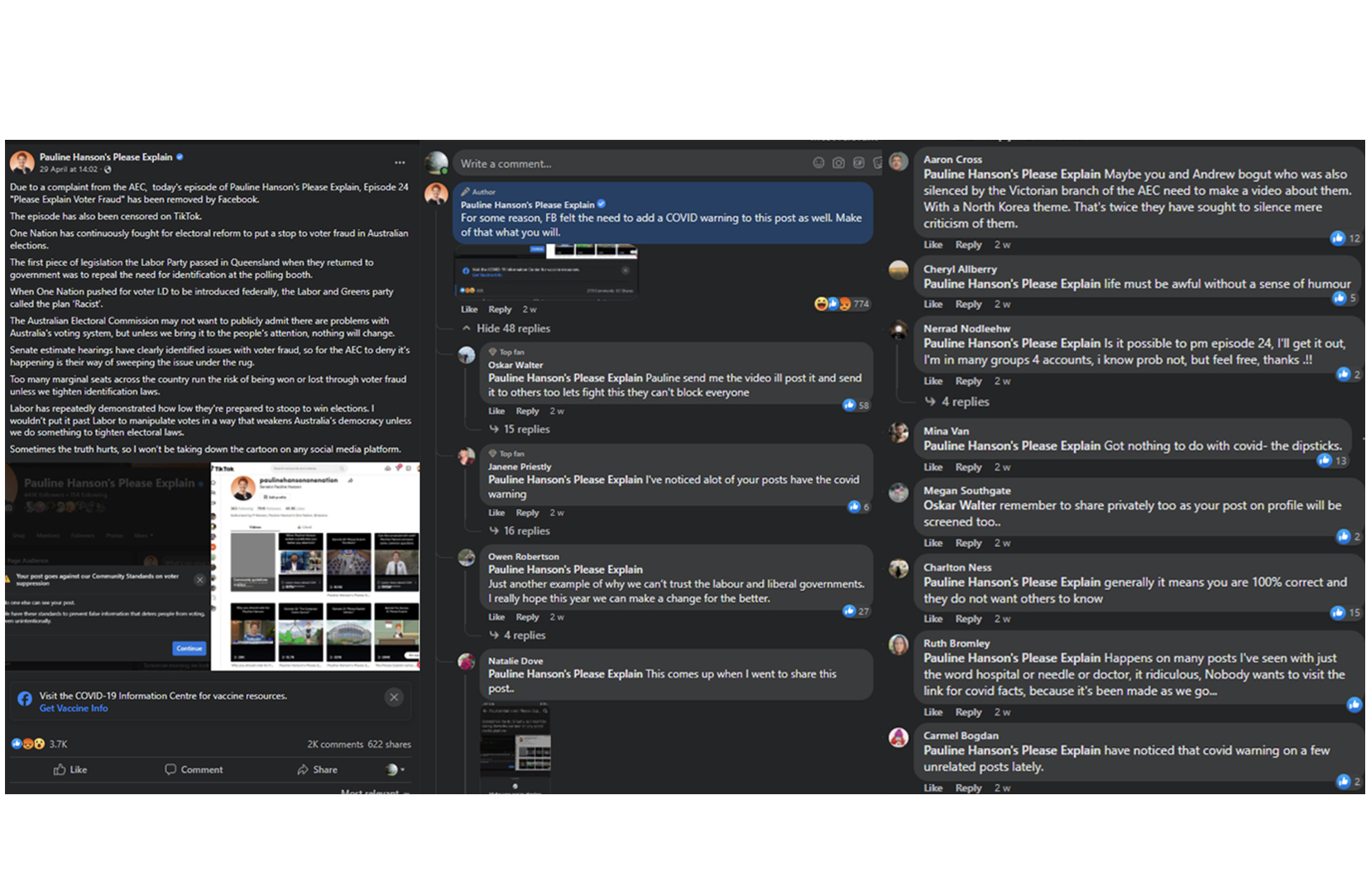
Beneath Hanson’s post users bemoaned the AEC’s decision. One commenter, whose response drew more than 200 user reactions of support, said they were “sick to death of all the censorship” and that the AEC’s complaint was “normalising dictatorship”. Other users accused the AEC of being a partisan entity, one going so far as to suggest the “AEC needs to be audited for corruption”.
The second response from One Nation was posted on April 6 and titled “AEC declares War on Cartoons” (source on One Nation website). In the post, the party said the AEC had escalated the issue to have all of the “Please Explain” cartoons removed from social media platforms. It promised its follower base that the videos would be relaunched.
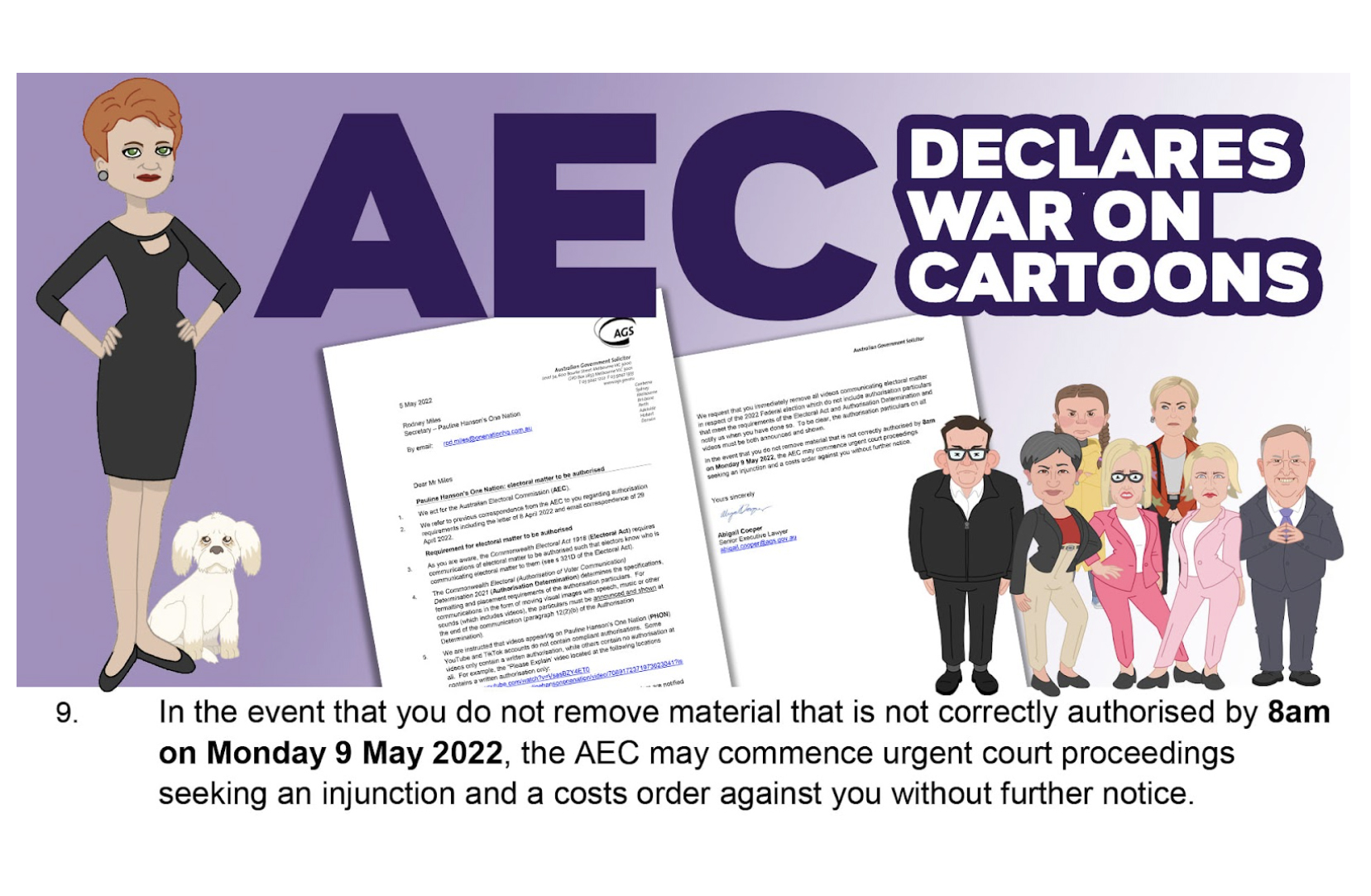
“If anything, the electoral commission have done us a massive favour and I suspect the commemorative special will amplify One Nation’s message right before early voting begins on Monday,” the post reads.
Fifteen of the videos have been re-published on the party's YouTube channel since the post. The series has gained a cult following, with some of the republished videos having received thousands of views within the first day of being uploaded. The most recent episode, published on May 13, has notched more than 60,000 views.
Sky News amplified One Nation’s opposition to the AEC’s decision. The media writer for The Australian, Sophie Elsworth, asserted on the Kenny Report the cartoon was a “satirical joke” and host Chris Kenny suggested the AEC should rethink its decision.
So how do voters sort satire from deliberately misleading information?
Anne Kruger, the director First Draft, a misinformation research organisation First Draft, noted: “Satire and parody is an enjoyable and important reflection on our culture and politics, a way for people to consider different sides of arguments, but requires understanding and content of issues first.”
Dr Kruger pointed to episode 24 of “Please Explain” as an example of satire being weaponised.
In one scene, a caricature of Labor frontbencher Penny Wong hands Opposition Leader Anthony Albanese, who is recovering from COVID-19, a bowl of soup from which a screeching bat flies.
The clip is referencing the false claim perpetuated through the early stages of the pandemic that COVID-19 originated from people eating “bat soup”.
Dr Kruger says these videos were used to fuel racism and intolerance towards the Chinese community, despite debunks that found that videos of a woman eating a bat that were widely circulating at the time were actually from Palau and three-years-old at the time.
“The problem of racism and xenophobia arose quickly at the start of the pandemic, and shows the potential for how damaging this type of weaponisation of content can be.”
Dr Kruger says misleading information about the electoral process and voter fraud is a familiar “tactic” used for undermining candidates with disinformation also causing confusion and sowing doubt about electoral processes and integrity.
“This was recently evident in the US 2020 election,” she says, adding that “Australia is no exception, and this election is adopting language and narratives from the US and mixing it with homegrown context”.
“It’s very easy to say, ‘Oh it’s just satire, it’s a joke’, but there are serious issues that have been ignored. This should not then be ‘normalised’ in an animated political party video."
Robert Phiddian, Professor of English at Flinders University agrees with Anne Kruger that context is essential for understanding a satirical piece, however, says it’s important to note that there's no law against bad satire.
“We need to understand that satire can be misleading and can be used for propaganda purposes, but just because you might not agree does not make it illegal to do”
“As long as the piece is clearly framed as a satirical comment rather than a statement of fact it is extremely unlikely to be found libellous.”
How the content of the “Please Explain” videos has evolved
Since the One Nation series was launched it has progressively featured more content that is either wrong or misleading. Premiering last November, the 27 episodes satirise the Canberra bubble, through a mix of brief explainers and party commentary on current issues.
The series has been one of the party’s main message platforms and has been successful in increasing visibility for the party. On YouTube, episodes from the series have overtaken Senator Hanson’s previous most popular uploads including her maiden speech, with the most watched episode of the series being viewed more than 260,000 times.
The party’s YouTube channel has also grown throughout the campaign with a 338 per cent increase in subscribers since March of last year (11.5k subscribers in March of last year to 50k subscribers as of 14 May).
A mixed bag
The majority of the “Please Explain” videos were released prior to the election being called. Among these episodes, many provide accurate and informative explainers around voting issues.
An example is episode 2, “Please Explain Preferences'', which addresses the old voter myth that one can “waste a vote”.
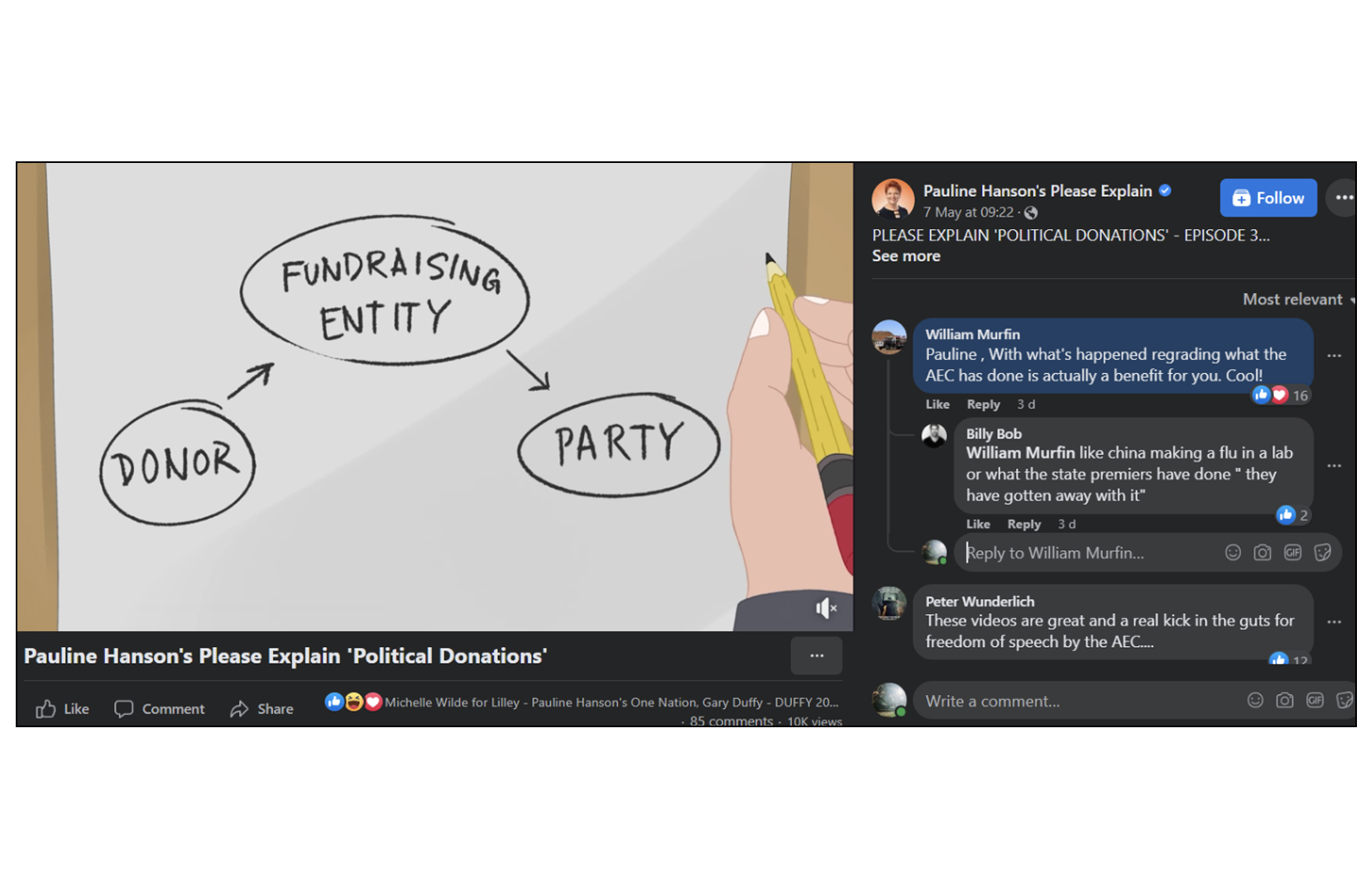
Other episodes explain voter issues of housing affordability (ep13), the Prime Minister’s pension (ep10) and concerns around the cost of living (ep21).
Dr Kruger says the explainers can “serve as an easy entry for audiences to One Nation, from which it can build its ‘tribe’, and from there tune its messaging”.
An example of this fine tuning can be lacing an explainer with misinformation –- information that is incorrect or misleading.
For example, episode 4, “Please Explain Taxes”, includes a false claim that Greens leader Adam Bandt wants to reintroduce a “death tax” that would take 50 per cent of an individual's estate.
This is misleading and has been debunked. While the Greens, and Adam Bandt, have previously supported a tax on estates, the policy was abandoned by the party in the last election and has not been referenced in the party's policy platform for this election.
Bait and Switch
After the election was called on April 10, the One Nation content shifted from explainers to focused party talking points. While earlier videos explored political donations and how bills are legislated, later episodes have focused on the party’s views on the media (ep23) and so-called “cancel” culture (ep 25).
Jiore Craig, of the Institute for Strategic Dialogue (ISD), a not–for-profit organisation researching and combating the global spread of disinformation, says this shift from informative material is an “acquisition strategy” to build a supportive follower base by building trust and then flipping the narrative.
Ms Craig says the tactic of introducing informative material initially allows the source to “account for and anticipate” future counter narratives. “That way, the audience has confirmation bias when the narrative is actioned.”
An example of this is the One Nation explainer “How to Vote Responsibly”, published alongside the “Please Explain” series. In the video, it is stated that Australians “are free to vote for whoever they like” and “elections are fair and without corruption”. The video celebrates Australian democracy and provides accurate voter information, encouraging viewers to trust One Nation as a source of electoral information.
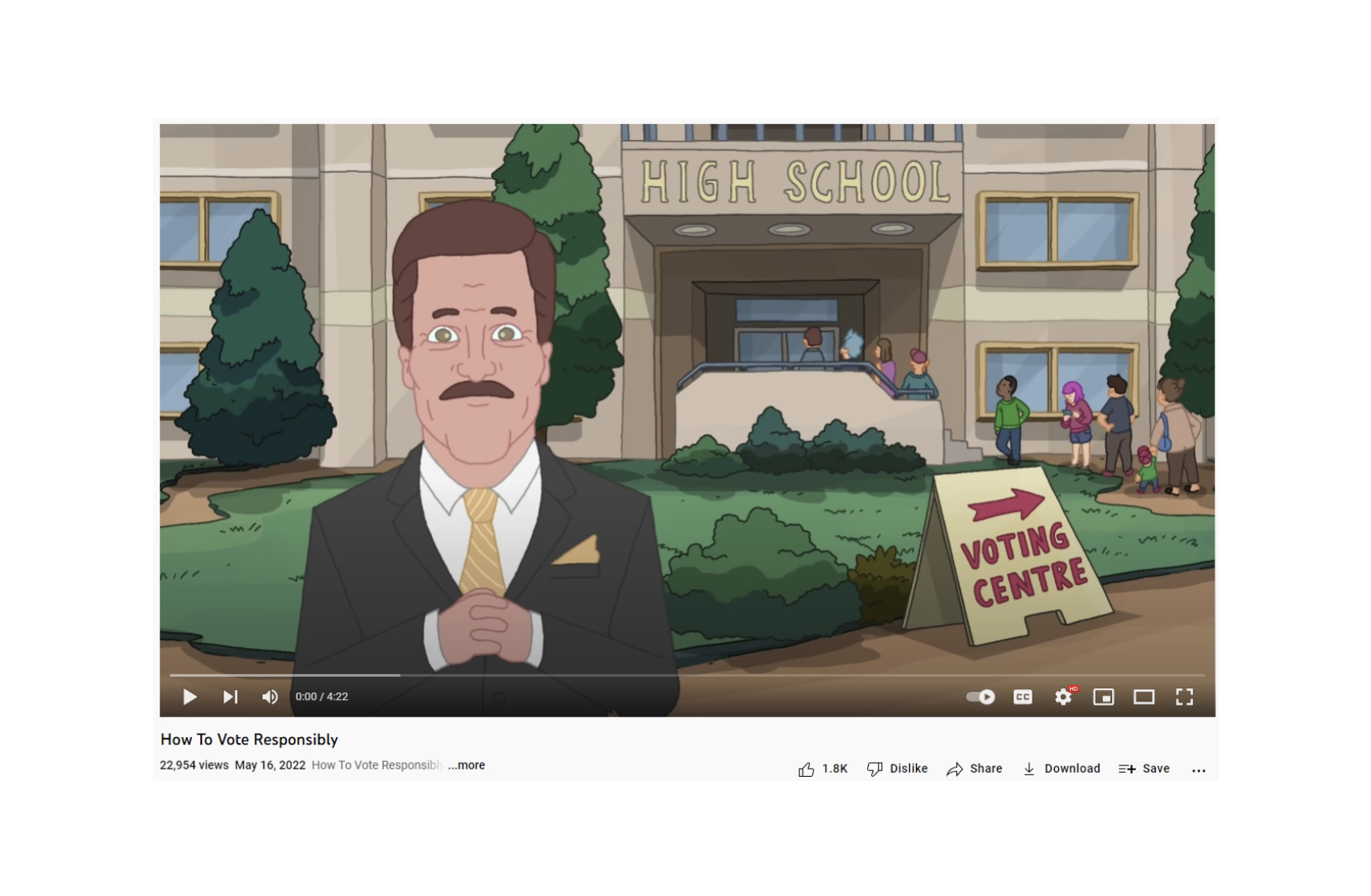
However, by episode 26, the representation of the body behind Australia’s elections, the AEC, is portrayed as an armed group forcibly shutting down One Nation’s message. In the episode, Senator Hanson is in the process of showing a clip from episode 24, when armed AEC staff burst into the classroom and shut down the demonstration.
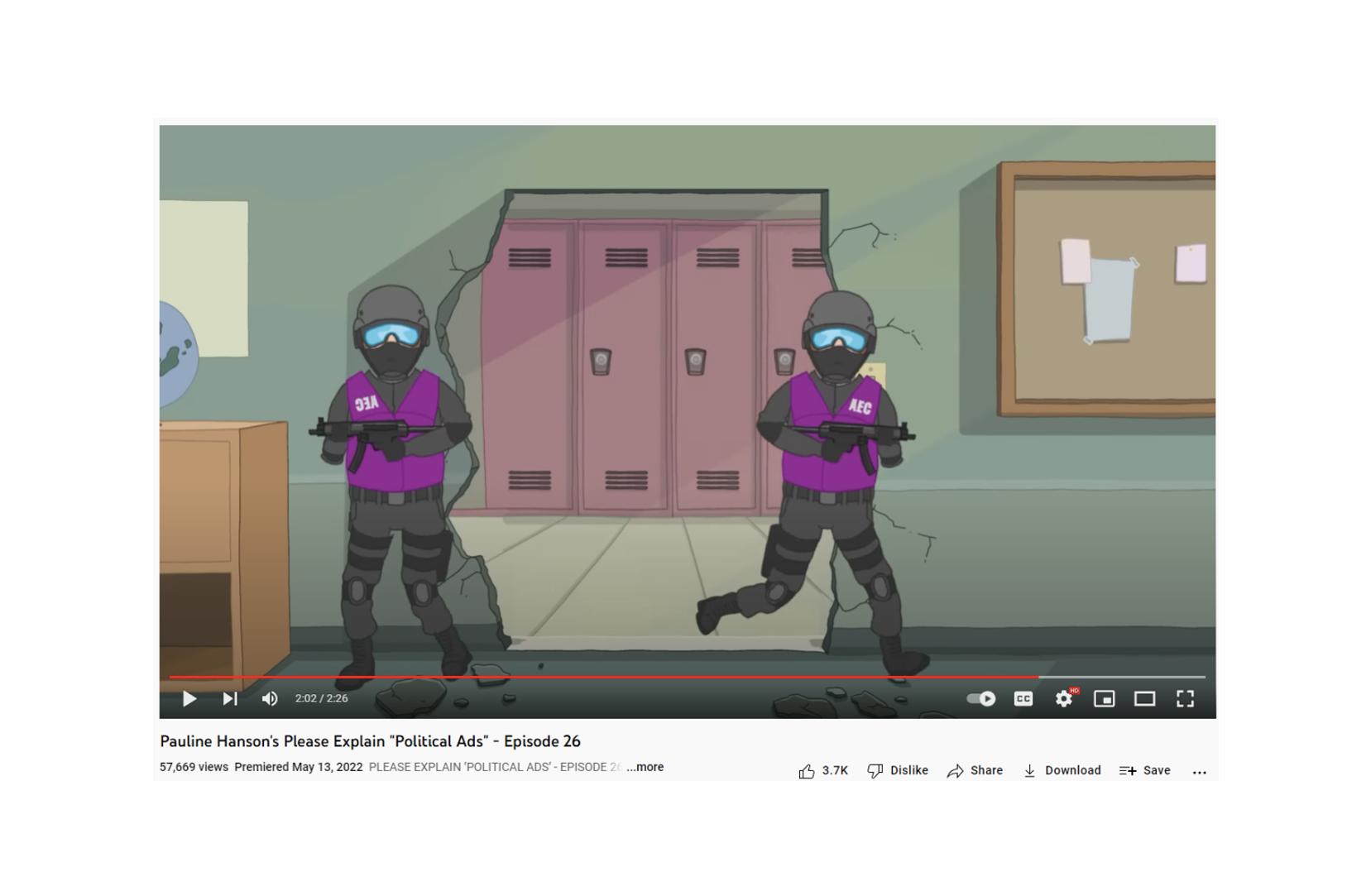
The inference is clear: that the AEC is working against the values of democracy as established in the earlier video. "Conspiracy narratives account for and thrive on anticipating its opposition,” says Ms Craig.
After the Election
First Draft’s Dr Kruger believes these messages could be impactful after the election. For those who believe the false information and “have invested their time in the surrounding narratives”, it is difficult “to remove themselves from this community and accept proof”.
The tactic of undermining the electoral processes and infrastructure bodies such as the AEC, according to Dr Kruger, gives licence to individuals to question polling results and the legitimacy of elected governments.
“We saw in the US, unofficial ‘scrutineers’ sent videos of the so-called ‘SharpieGate’ to spread misinformation after ballots closed,” she notes. “Unfortunately, the voter fraud tactics are simply using the tactic of sowing doubt, without proof. We want people to be sceptical, but not cynical.”


Acknowledgement of Country
RMIT University acknowledges the people of the Woi wurrung and Boon wurrung language groups of the eastern Kulin Nation on whose unceded lands we conduct the business of the University. RMIT University respectfully acknowledges their Ancestors and Elders, past and present. RMIT also acknowledges the Traditional Custodians and their Ancestors of the lands and waters across Australia where we conduct our business - Artwork 'Sentient' by Hollie Johnson, Gunaikurnai and Monero Ngarigo.
More information